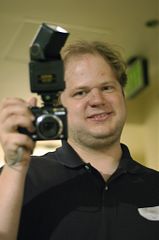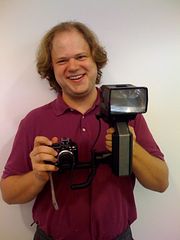Better Lighting Through High Voltage: Sunpak 383 Super is Gone / My new Sunpak 622

Showing off the flash and camera
I've been pondering lately what I need to get my lighting gear back together. See, I've been bleeding strobes. First the one 383 super ended up in the bay, then my MS-1 failed, then my other 383 super failed, which leaves me the Sunpak Digital Flash and my Sunpak 144PC. The Digital Flash is OK, albeit low in power and the 144PC is what I use to trigger flashes, so that's just not comfortable.
Before the second 383 Super completely failed, I started getting nervous and ordered a new flash. More about that later.
David the Strobist guy usually uses his Nikon hotshoe flashes. And he's got a whole set of them so that he can be assured every flash will be identical to the others. Most of the pros who use strobist techniques seem to go this route, given that Canon and Nikon have a better grip on the quality banner than Vivitar and Sunpak. Plus, you retain the option of using the sophisticated TTL setup.
Good strobist flashes are popular, but I suspect they are not a great business to be in. There does seem to be a good amount of demand... David singlehandedly drove up the used prices for all the old old Nikon flashes with some of his blog entries when everybody realized they could get a lot of bang for the buck out of them in ways they didn't before. The problem is that you are catering to a largely price-sensitive market with strobist flashes. The price point seems to be under a hundred bucks. You have to be less expensive than the decent monolights and dedicated flashes.
So what we've been seeing mostly is older gear that never left the market. Except that eventually some part you need to make the flash will be discontinued or RoHS comes into effect or whatnot and suddenly the flash requires an expensive redesign that the sales won't support. And you won't even know it for quite a while after they stop making them because they may have plenty in the store room for a while.
I'm concerned because I really hate paying a bunch of money for dedicated flash functionality I won't use most of the time. And I really like being able to grab a bunch of fairly lightweight gear (Iona Lynn had the story about when she offered to carry some of the gear on a distant shoot and ended up carrying somebody's heavy lead-acid battery Vagabond pack) and take my pictures, so I need at least some of my lighting hardware to be compact battery-powered strobes.
The Sunpak 383 Super is gone
The 383 super, until mine went nasty on me, was a great idea. It's available new, manual, and inexpensive. And it's got a lovely tilt-swivel mount so you can twist it in all sorts of useful angles for better bouncing.
But I need to understand what failed. See, the one that failed was my oldest flash and it lived in the camera bag. I'm trying to figure out if the swivel bracket on the 383 super is just under engineered or if I was just unlucky or if it was damaged when I went into the bay but I didn't realize it.
Either way, I'm mostly doing this for the people who I recommended the 383 super to more than for myself. The Sunpak 383 Super has been discontinued, according to Sunpak, although most sites haven't listed it as gone yet, just backordered. It's gone from the US Sunpak website and listed as discontinued on the Japanese side.
Vivitar 285HV
This is the name-brand die-hard standard that was on the market for a long long time. The old ones were built like a tank. The new ones... not so much. The first batch out was really crappy and most of them died within a few months. The second batch is said to be better.
The advantage over the 383 super is the zoom head. The disadvantage over the 383 super is the lack of a swivel head, just tilt.
I'm tending to think that I'll just get several 285HV's used, because I might end up getting at least some built-like-a-tank older versions and also because you can't really find 383 supers used. At some point.
Enter the Sunpak 622 Pro
I decided to do something really weird. I got a used Sunpak 622 Pro. See, I figure that the flash bracket will come in handy and I could use the extra power (The 383 super has a guide number of 120, whereas the 622, at the same coverage setting, will do 160. Plus, I can zoom in and get even more power).
Actually, let's get down to the real reason why I got a 622 Super:

My Sunpak 622 Pro and my G7
Because a Potato Masher flash paired with my Canon G7 looks really funny.
These are mostly intended for medium format and weddings, so they take bigger batteries and put out a lot more light and double as a flash bracket. My 622 has interchangeable heads. Mine came with the zoom head, but there's six others, including a bare bulb head. And it can get both brighter and darker than my old 383 super. At full power, it's brighter, but it also goes down to 1/128 power.
So I'll post in another few weeks a proper review of the 622.












